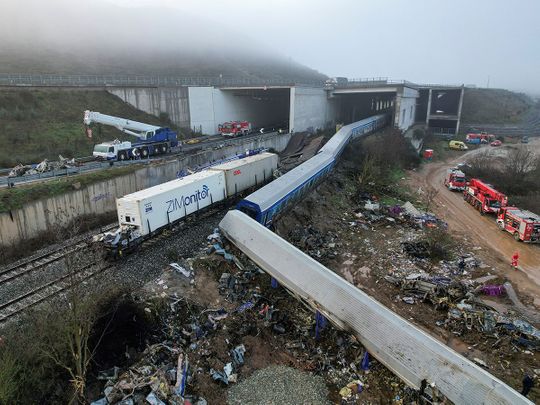
Larissa: Checks of all the human remains recovered so far from the scene of the deadliest train crash in Greece's history indicate the number of people killed in this week's rail disaster still stands at 57, authorities said Friday.
Recovery teams spent a third day scouring the wreckage in Tempe, 380 kilometers (235 miles) north of Athens, where a passenger train slammed into a freight carrier just before midnight Tuesday.
The force of the head-on collision and a resulting fire has complicated the task of determining the death toll. Officials are matching parts of dismembered and burned bodies with tissue samples to establish the number.
The remains were being returned to families in closed caskets following the identification of victims through next-of-kin DNA samples.
Relatives of passengers still listed as unaccounted-for waited outside a hospital in the central city of Larissa for news. Among them was Mirella Ruci, whose 22-year-old son, Denis, remained missing.
"My son is not on any official list so far and I have no information. I am pleading with anyone who may have seen him, in rail car 5, seat 22, to contact me if they may have seen him,” Ruci, who struggled to stop her voice from cracking, told reporters.
Health Ministry officials said all victim identifications would be carried out by cross-matching DNA samples from relatives due to the condition of so many of the bodies.
Police and civilian forensics specialists set up teams to run the complex, round-the-clock identification process, which involves two stages: Matching body parts to each individual victim and then establishing identities using DNA samples from relatives of missing passengers.
Flags at the ancient Acropolis, parliament and other public buildings in Athens remained at half-staff on the third day of national mourning, while national rail services were halted by a strike for a second day.
Anger against authorities in the wake of the tragedy grew over reports that the rail network lacked adequate safeguards to reduce the impact of human error. Not far from the hospital in Larissa, several thousand school children gathered in protest in a central square, chanting “You never arrived, we will avenge you!”
A demonstration organized by student groups was also underway in Athens, where hundreds of protesters chanting “Murderers!” and held up white balloons for the victims, blocking traffic in the center of the capital..
Police early Friday searched a rail coordination office in Larissa, removing evidence as part of an ongoing investigation.
The facility's 59-year-old station manager, who was arrested and charged with multiple counts of negligent manslaughter, is due to testify before a public prosecutor on Saturday.
Stelios Sourlas, a lawyer representing a 23-year-old victim of the collision, said the responsibility for the deaths went beyond the station manager.
“The station manager may have the principle responsibility ... but the responsibility is also broader: There are the rail operators and public officials whose job it was to ensure that safety measures and procedures were properly in place,” Sourlas said.
Rail unions say the network was poorly maintained despite rail service upgrades to provide faster trains in recent years.
Greece's center-right government had been expected Friday to call national elections for early April, but the announcement and likely date was likely to be delayed.
The passenger train involved in the crash was traveling along Greece's busiest route, from the capital to the country's second-largest city, Thessaloniki.
Two of the victims were identified Friday as Cypriot students Anastasia Adamidou and Kyprianos Papaioannou. Cyprus President Nikos Christodoulides said the state would covers all costs relating to their repatriation and funerals.












